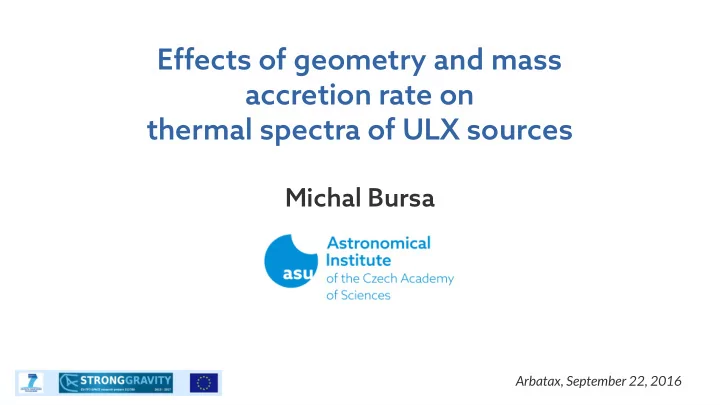

E f f e c t s o f g e o me t r y a n d ma s s a c c r e t i o n r a t e o n t h e r ma l s p e c t r a o f U L X s o u r c e s Mi c h a l B u r s a Arbatax, September 22, 2016
Motivation (Gladstone et al. 2009) Spectral modeling of ULXs: ● most often a model with disk+pl or disk+th_comp is used ● in place of a disk model we can see DISKBB, DISKPN, KERRBB, BHSPEC, GRAD, etc ● all of the listed disk models are based on thin disk model, which is inaccurate for L > 0.3 L Edd ● BUT, such a modelling tends to give incorrect values for BH masses and for accretion rate (luminosity) ● how much wrong?
Motivation (Gladstone et al. 2009) Spectral modeling of ULXs: ● most often a model with disk+pl or disk+th_comp is used ● in place of a disk model we can see DISKBB, DISKPN, KERRBB, BHSPEC, GRAD, etc ● all of the listed disk models are based on thin disk model, which is inaccurate for L > 0.3 L Edd ● BUT, such a modelling tends to give incorrect values for BH masses and for accretion rate (luminosity) ● how much wrong?
Spectral model based on slim disk model Analytical solutions Numerical simulations Credit: A. Sadowski Sadowski+2009
Spectral softening: advection & geometry
ULX spectra (a=0.00, i=30°)
ULX spectra (a=0.00, i=30°)
ULX spectra (a=0.00, i=30°)
ULX spectra (a=0.00, i=30°)
ULX spectra (a=0.00, i=30°)
ULX spectra (a=0.00, i=60°)
ULX spectra (a=0.00, i=60°)
ULX spectra (a=0.00, i=60°)
ULX spectra (a=0.00, i=60°)
ULX spectra (a=0.00, i=60°)
ULX spectra (a=0.00, i=60°)
Luminosity vs. Temperature L-T plot in super-eddington case: inc=0° ● standard (thin) disks follow L~T 4 relation ● advection and obscuration effects cause signifjcant deviations from that relation in super-Eddington regime ● the effect is strongly inclination dependent ● observed luminosity can stay arround eddington even if mass accretion rate is >>1 ● that has implications for spectral modeling
Luminosity vs. Temperature L-T plot in super-eddington case: inc=0° ● standard (thin) disks follow L~T 4 relation ● advection and obscuration effects cause signifjcant deviations from that relation in super-Eddington regime ● the effect is strongly inclination dependent ● observed luminosity can stay arround eddington even if mass accretion rate is >>1 ● that has implications for spectral modeling
Luminosity vs. Temperature L-T plot in super-eddington case: inc=0° ● standard (thin) disks follow L~T 4 relation ● advection and obscuration effects cause signifjcant deviations from that relation in super-Eddington regime ● the effect is strongly inclination dependent ● observed luminosity can stay arround eddington even if mass accretion rate is >>1 ● that has implications for spectral modeling
Luminosity vs. Temperature L-T plot in super-eddington case: inc=0° ● standard (thin) disks follow L~T 4 relation ● advection and obscuration effects cause signifjcant deviations from that relation in super-Eddington regime ● the effect is strongly inclination dependent ● observed luminosity can stay arround eddington even if mass accretion rate is >>1 ● that has implications for spectral modeling inc=70°
Luminosity vs. Temperature L-T plot in super-eddington case: ● standard (thin) disks follow L~T 4 relation ● advection and obscuration effects cause signifjcant deviations from that relation in super-Eddington regime ● the effect is strongly inclination dependent ● observed luminosity can stay arround eddington even if mass accretion rate is >>1 ● that has implications for spectral modeling Poutanen+2007
Mass estimates from thermal spectra 40 SLIMULX spectra fjtted with DISKBB ● simulated SLIMULX spectra are fjtted 35 with a thin disk model (DISKBB) and mass is obtained from the fjt 30 inc=60° BH mass [M ⊙ ] ● at low Mdot, the fjt recovers the original 25 mass, but at high Mdot, mass is much larger ● it appears to be quite tricky to estimate 20 the ULX source parameters using inc=30° thin disk models if the disk is strongly 15 radiation pressure dominated 10 ● masses may be largely overestimated 0.1 0.5 1 5 10 accretion rate [ ˙ M Edd ]
Limitations Model limitations ● vertical equilibrium treatment (Q~R -3 instead of Q~[R 2 +z 2 ] -3/2 ) limits H/R to ~1 ● constant mass accretion rate, the solution misses transfer of gas to outfmow ● refmection of radiation in the inner funnel; beaming ● feadback from radiation on the disk structure and shape ● hardening factor treatment Fixes ● use insight from numerical simulations to apply scaling to the analytic model, possibly with accounting for comptonization in the outfmowing wind
Summary ● slimulx model can be used fjt BHB UXL spectra ● the model spectra reproduce a turnover in L-T track ● compared to thin disk models, it gives lower BH masses
Recommend
More recommend